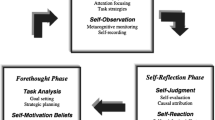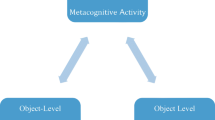Abstract
Mathematics education research has documented several classroom practices that might influence student self-regulation. We know little, however, about the ways these classroom practices could be structured in real classroom settings. In this exploratory case study, we purposefully selected a sixth-grade mathematics teacher who had participated in a professional development program focussed on NCTM standards and SRL in the mathematics classroom for extensive classroom observation. The purpose was to explore how and to what extend she structured classroom practices to support strategic competence in her students. Four features of classroom practices were found as evidence for how strategic competence was potentially supported in this classroom: (a) allowing autonomy and shared responsibility during the early stages of learning, (b) focusing on student understanding, (c) creating contexts for students to learn about strategic learning and to exercise strategic behaviour, and (d) helping students to personalise strategies by recognising their ideas and strategic behaviours.
Similar content being viewed by others
Notes
All names are pseudonymous.
References
Ainley, M., & Patrick, L. (2006). Measuring self-regulated learning processes through tracking patterns of student interaction with achievement activities. Educational Psychology Review, 18, 267–286.
Blumenfeld, P. C., Puro, P., & Mergendoller, J. R. (1992). Translating motivation into thoughtfulness. In H. Marshall (Ed.), Redefining student learning: Roots of educational change (pp. 207–239). Norwood: Ablex.
Boekaerts, M., & Corno, L. (2005). Self-Regulation in the classroom: A perspective on assessment and intervention. Applied Psychology: An International Review, 54, 199–231.
Brophy, J. (1999). Research on motivation in education: past, present and future. In T. Urdan, M. Maehr, & P. R. Pintrich (Eds.), Advances in motivation and achievement (Vol. 11, pp. 1–44). Connecticut: JAI.
Butler, D. L. (1998a). In search of the architect of learning: A commentary on scaffolding as a metaphor for instructional interactions. Journal of Learning Disabilities, 31, 374–385.
Butler, D. L. (1998b). The strategic content learning approach to promoting self-regulated learning: A report of three studies. Journal of Educational Psychology, 90, 682–697.
Butler, D. (1998c). A strategic content learning approach to promoting self-regulated learning by students with learning disabilities. In D. H. Schunk & B. J. Zimmerman (Eds.), Self-regulated learning: From teaching to self-reflective practice (pp. 160–183). New York: Guilford.
Butler, D. L. (2002a). Qualitative approaches to investigating self-regulated learning: Contributions and challenges. Educational Psychologist, 37, 59–63.
Butler, D. L. (2002b). Individualizing instruction in self-regulated learning. Theory into Practice, 41, 81–92.
Butler, D. L., Elaschuk, C. L., Poole, S. L., Novak, H. J. & Karvat, F. C. (2000, April). Investigating an application of strategic content learning: Promoting strategy development in group contexts. Paper presented at the annual meetings of the American Educational Research Association, New Orleans, LA.
Butler, D. L., Jarvis, S., Beckingham, B., Novak, H., & Elaschuk, C. (2001, April). Teachers as facilitators of students’ strategic performance: Promoting academic success by secondary students with learning difficulties. Paper presented at the annual meetings of the American Educational Research Association, Seattle, WA.
Butler, D. L., Beckingham, B., & Lauscher, H. (2005). Promoting strategic learning by eighth-grade students struggling in mathematics: A report of three case studies. Learning Disabilities Research and Practice, 20, 156–174.
Cole, M. (1985). The zone of proximal development: where culture and cognition create each other. In J. Wertsch (Ed.), Culture, communication, and cognition: Vygotskian perspectives (pp. 146–162). New York: Cambridge University Press.
Meece, J. L. (1991). The classroom context and students’ motivational goals. In M. L. Maehr & P. R. Pintrich (Eds.), Advances in motivation and achievement: A research annual (Vol. 7, pp. 261–285). Greenwich: JAI.
Meyer, D. K., & Turner, J. C. (2002). Using instructional discourse analysis to study the scaffolding of student self-regulation. Educational Psychologist, 37, 17–25.
National Council of Teachers of Mathematics. (2000). Principles and standards for school mathematics. Reston, VA
Palincsar, A., & Brown, A. (1984). Reciprocal teaching of comprehension fostering and monitoring activities. Cognition and Instruction, 1, 117–175.
Pape, S. J., & Costner, B. G. (2002, Autumn). Professional development supporting teacher reflection: Building the relationship between standards, research, and teacher reflective practice. Ohio Journal of School Mathematics, 46, 8–13.
Pape, S. J., & Wang, C. (2003). Middle school children’s strategic behavior: Classification and relation to academic achievement and mathematical problem solving. Instructional Science, 31, 419–449.
Pape, S. J., Bell, C. V., & Yetkin, İ. E. (2003). Developing mathematical thinking and self-regulated learning: A teaching experiment in a seventh-grade mathematics classroom. Educational Studies in Mathematics, 53, 179–202.
Paris, S. G., & Turner, J. C. (1994). Situated motivation. In P. Pintrich, D. Brown, & C. Weinstein (Eds.), Student motivation, cognition, and learning. Essays in honor of Wilbert J. McKeachie, 213-237. Hillsdale: Lawrence Erlbaum Associates, Inc.
Patrick, H., & Middleton, M. J. (2002). Turning the kaleidoscope: What we see when self-regulated learning is viewed with a qualitative lens. Educational Psychologist, 37, 27–39.
Patrick, H., Ryan, A. M., Anderman, L. H., Middleton, M., Linnenbrink, L, Hruda, L. Z., Edelin, K., Kaplan, A., & Midgley, C. (1997). Manual for Observing Patterns of Adaptive Learning (OPAL): A Protocol for Classroom Observations. Ann Arbor: University of Michigan. (available at www.umich.edu/~pals/pals/manuals.html).
Patrick, H., Anderman, L. H., Ryan, A. M., Edelin, K., & Midgley, C. (2001). Teachers’ communication of goal orientations in four fifth-grade classrooms. The Elementary School Journal, 102, 35–58.
Patton, M. (2002). Qualitative research and evaluation methods. Thousand Oaks: Sage.
Perry, N. E. (1998). Young children’s self-regulated learning and contexts that support it. Journal of Educational Psychology, 90, 715–729.
Perry, N. E. (2002). Introduction: Using qualitative methods to enrich understandings of self-regulated learning. Educational Psychologist, 37, 1–3.
Perry, N. E., VandeKamp, K. O., Mercer, L. K., & Nordby, C. J. (2002). Investigating teacher-student interactions that foster self-regulated learning. Educational Psychologist, 37, 5–15.
Pintrich, P. R. (1989). The dynamic interplay of student motivation and cognition in the college classroom. In C. Ames & M. L. Maehr (Eds.), Advances in motivation and achievement: Motivation enhancing environments (Vol. 6, pp. 117–160). Greenwich: JAI.
Pintrich, P. R., & De Groot, E. V. (1990). Motivational and self-regulated learning components of classroom academic performance. Journal of Educational Psychology, 82, 33–40.
Pintrich, P., Smith, D., Garcia, T., & McKeachie, W. (1993). Predictive validity and reliability of the Motivated Strategies for Learning Questionnaire. Educational and Psychological Measurement, 53, 801–813.
Rogoff, B. (1990). Apprenticeship in thinking: Cognitive development in social context. New York: Oxford University Press.
Schoenfeld, A. H. (1985). Mathematical problem-solving. New York: Academic.
Schoenfeld, A. H. (1987). What’s all the fuss about metacognition? In A. H. Schoenfeld (Ed.), Cognitive science and mathematics education (pp. 189–215). Hillsdale: Lawrence Erlbaum.
Stefanou, C. R., Perencevich, K. C., DiCintio, M., & Turner, J. C. (2004). Supporting autonomy in the classroom: Ways teachers encourage student decision making and ownership. Educational Psychologist, 39, 97–110.
Stipek, D. J., Salmon, J. M., Givvin, K. B., Kazemi, E., & Saxe, G. B. (1998). The value (and convergence) of practices suggested by motivation research and promoted by mathematics education reformers. Journal for Research in Mathematics Education, 29, 465–488.
Tharp, R., & Gallimore, R. (1988). Rousing minds to life: Teaching, learning, and schooling in social context. New York: Cambridge University Press.
Turner, J. C. (2006). Measuring self-regulation: A focus on activity. Educational Psychology Review, 18, 293–296.
Turner, J. C., Cox, K. E., DiCintio, M., Meyer, D. K., Logan, C., & Thomas, C. T. (1998). Creating contexts for involvement in mathematics. Journal of Educational Psychology, 90, 730–745.
Turner, J. C., Meyer, D. K., Anderman, E. M., Midgley, C., Cheen, M., & Kang, Y. (2002). The classroom environment and students’ reports of avoidance strategies in mathematics: A multimethod study. Journal of Educational Psychology, 94, 88–106.
Turner, J. C., Meyer, D. K., Midgley, C., & Patrick, H. (2003). Teacher discourse and sixth graders’ reported affect and achievement behaviors in two high-mastery/ high- performance mathematics classrooms. The Elementary School Journal, 103, 357–382.
Vermunt, J. D., & Verloop, N. (1999). Congruence and friction between learning and teaching. Learning and Instruction, 9, 257–280.
Verschaffel, L., De Corte, E., Lasure, S., Van Vaerenbergh, G., Bogaerts, H., & Ratinckx, E. (1999). Learning to solve mathematical application problems: A design experiment with fifth graders. Mathematical Thinking and Learning, 1, 195–229.
Weiner, B. (1996). Foreword. In J. Juvonen & K. Wentzel (Eds.), Social motivation: Understanding children's school adjustment (pp. xiii–xv). New York: Cambridge University Press.
Weinstein, C. E., & Mayer, R. E. (1986). The teaching of learning strategies. In M. Wittrock (Ed.), Handbook of research on teaching (pp. 315–327). New York: Macmillan.
Wertsch, J. V. (1985). Vygotsky and the social formation of mind. Cambridge: Harvard University Press.
Winne, P. H., & Perry, N. E. (2000). Measuring self-regulated learning. In M. Boekaerts, P. R. Pintrich, & M. Zeidner (Eds.), Handbook of self-regulation (pp. 531–566). San Diego: Academic.
Yetkin, İ. E. (2006). The role of classroom context in student self-regulated learning: An exploratory case study in a sixth-grade mathematics classroom. Unpublished doctoral dissertation, The Ohio State University, Columbus, OH.
Zimmerman, B. J. (2000). Attaining self-regulation: A social cognitive perspective. In M. Boekaerts, P. R. Pintrich, & M. Zeidner (Eds.), Handbook of self-regulation (pp. 13–39). San Diego: Academic.
Zimmerman, B. J., & Martinez-Pons, M. (1986). Development of a structured interview for assessing student use of self-regulated learning strategies. American Educational Research Journal, 23, 614–628.
Zimmerman, B. J., & Martinez-Pons, M. (1988). Construct validation of a strategic model of student self-regulated learning. Journal of Educational Psychology, 80, 284–290.
Zimmerman, B. J., & Martinez-Pons, M. (1990). Student differences in self-regulated learning: Relating grade, sex, and giftedness to self-efficacy and strategy use. Journal of Educational Psychology, 82, 51–59.
Author information
Authors and Affiliations
Corresponding author
Rights and permissions
About this article
Cite this article
Özdemir, İ.E.Y., Pape, S.J. Supporting students’ strategic competence: a case of a sixth-grade mathematics classroom. Math Ed Res J 24, 153–168 (2012). https://doi.org/10.1007/s13394-012-0033-8
Received:
Revised:
Accepted:
Published:
Issue Date:
DOI: https://doi.org/10.1007/s13394-012-0033-8




